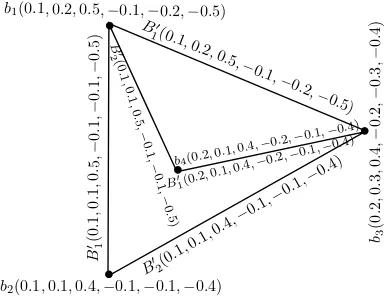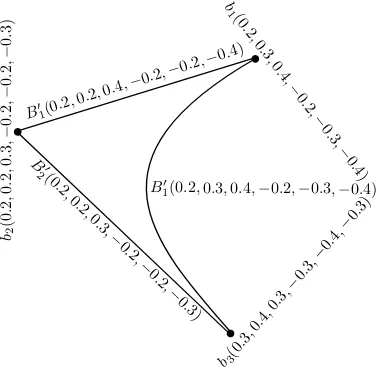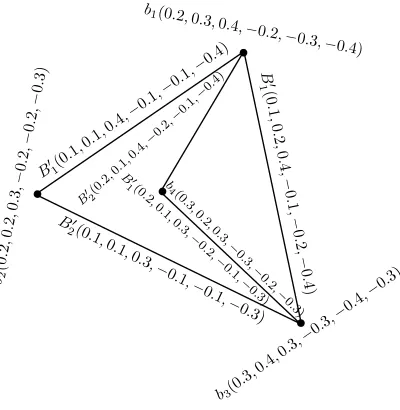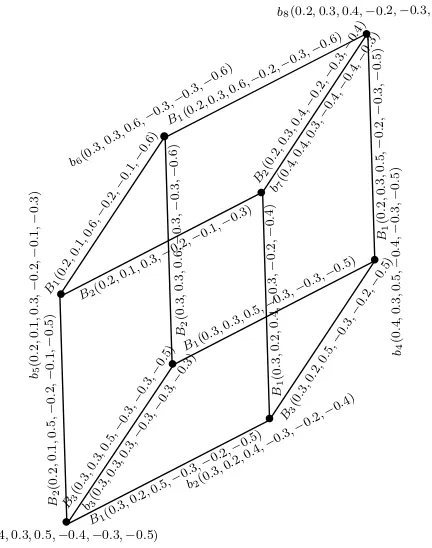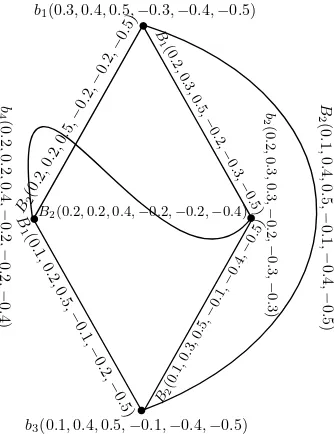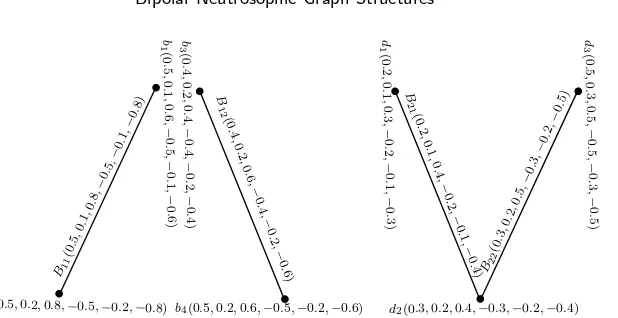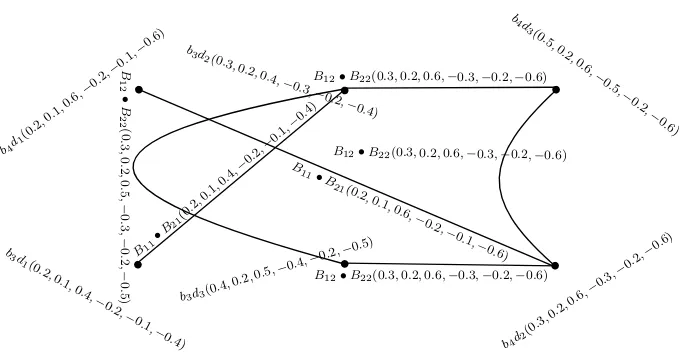Vol. 23, No. 1 (2017), pp. 55–80.
BIPOLAR NEUTROSOPHIC GRAPH STRUCTURES
Muhammad Akram
1and Muzzamal Sitara
21
Department of Mathematics, University of the Punjab, New Campus, Lahore, Pakistan,
2
Department of Mathematics, University of the Punjab, New Campus, Lahore, Pakistan,
Abstract.In this research study, we introduce the concept of bipolar single-valued neutrosophic graph structures. We discuss certain notions of bipolar single-valued neutrosophic graph structures with examples. We present some methods of con-struction of bipolar single-valued neutrosophic graph structures. We also investigate some of their prosperities.
Key words and Phrases: Graph structure, bipolar single-valued neutrosophic graph structure, operations.
Abstrak. Pada penelitian ini, kami memperkenalkan konsep struktur graf neu-trosofik bipolar bernilai tunggal. Kami mengkaji ide-ide tertentu dari struktur graf neutrosofik bipolar bernilai tunggal berserta contoh-contohnya. Kami menya-jikan beberapa metode konstruksi struktur graf neutrosofik bipolar bernilai tunggal. Kami juga memeriksa beberapa sifat-sifat mereka.
Kata kunci: Striktur graf, struktur graf neutrosofik bipolar bernilai tunggal, operasi
1. Introduction
Fuzzy graph theory has a number of applications in modeling real time sys-tems where the level of information inherent in the system varies with different levels of precision. Fuzzy models are becoming useful because of their aim in re-ducing the differences between the traditional numerical models used in engineering and sciences and the symbolic models used in expert systems. In 1973, Kauffmann [13] illustrated the notion of fuzzy graphs based on Zadeh’s fuzzy relations [24]. Rosenfeld [16] discussed several basic graph-theoretic concepts, including bridges,
2000 Mathematics Subject Classification: 03E72, 68R10, 68R05. Received: 02-02-2017, revised: 02-03-2017, accepted: 03-02-2017.
cut-nodes, connectedness, trees and cycles. Later on, Bhattacharya [8] gave some remarks on fuzzy graphs. In 1994, Mordeson and Chang-Shyh [14] defined some operations on fuzzy graphs. The complement of fuzzy graph was defined in [14]. Further, this concept was discussed by Sunitha and Vijayakumar [20]. Akram de-scribed bipolar fuzzy graphs in 2011 [1]. Akram and Shahzadi [5] dede-scribed the concept of neutrosophic soft graphs with applications. Dinesh and Ramakrishnan [12] introduced the concept of the fuzzy graph structure and investigated some re-lated properties. Akram and Akmal [4] proposed the notion of bipolar fuzzy graph structures. On the other hand, Dhavaseelan et al. [10] defined strong neutrosophic graphs. Akram and Sarwar [3] portrayed bipolar neutrosophic graphs with appli-cations. Akram and Shahzadi [5] introduced the notion of neutrosophic soft graphs with applications. Akram [2] introduced the notion of single-valued neutrosophic planar graphs. Representation of graphs using intuitionistic neutrosophic soft sets was discussed in [6]. Single-valued neutrosophic minimum spanning tree and its clustering method were studied by Ye [22]. In this research study, we introduce the concept of bipolar single-valued neutrosophic graph structures. We discuss certain notions of bipolar single-valued neutrosophic graph structures with examples. We present some methods of construction of bipolar single-valued neutrosophic graph structures. We also investigate some of their prosperities.
2. BIPOLAR SINGLE-VALUED NEUTROSOPHIC GRAPH
STRUCTURES
Smarandache [19] introduced neutrosophic sets as a generalization of fuzzy sets and intuitionistic fuzzy sets. A neutrosophic set has three constituents: truth-membership, indeterminacy-membership and falsity-truth-membership, in which each membership value is a real standard or non-standard subset of the unit interval ]0−
,1+[. In real-life problems, neutrosophic sets can be applied more appropriately
by using the single-valued neutrosophic sets defined by Smarandache [19] and Wang et al [21].
Definition 2.1. [19] Aneutrosophic set N on a non-empty setV is an object of the form
N ={(v, TN(v), IN(v), FN(v)) :v∈V} where, TN, IN, FN :V →]0
−
,1+[ and there is no restriction on the sum of T
N(v),
IN(v) andFN(v) for allv∈V.
Definition 2.2. [21]A single-valued neutrosophic set N on a non-empty set V is an object of the form
N ={(v, TN(v), IN(v), FN(v)) :v∈V}
Deli et al. [9] defined bipolar neutrosophic sets a generalization of bipolar fuzzy sets. They also studied some operations and applications in decision making problems.
Definition 2.3. [9]Abipolar single-valued neutrosophic seton a non-empty setV
is an object of the form
B={(v, TP B(v), I
P B(v), F
P B(v), T
N B(v), I
N B(v), F
N
B(v)) :v∈V}
where, TP B, I
P B, F
P
B :V →[0,1] andT N B, I
N B, F
N
B :V →[−1,0]. The positive values
TP B(v), I
P B(v), F
P
B(v) denote the truth, indeterminacy and falsity membership values of an element v ∈ V, whereas negative valuesTN
B(v), I N B(v), F
N
B(v) indicates the implicit counter property of truth, indeterminacy and falsity membership values of an elementv∈V.
Definition 2.4. A bipolar single-valued neutrosophic graphon a non-empty setV
is a pairG= (B, R), whereBis a bipolar single-valued neutrosophic set onV and
R is a bipolar single-valued neutrosophic relation inV such that
TP
R(bd)≤T P B(b)∧T
P B(d), I
P
R(bd)≤I P B(b)∧I
P
B(d), F P
R(bd)≤F P B(b)∨F
P B(d),
TN
R(bd)≥T N B(b)∨T
N B(d), I
N
R(bd)≥I N B(b)∨I
N
B(d), F N
R(bd)≥F N B(b)∧F
N B(d), for allb, d∈V.
We now define bipolar single-valued neutrosophic graph structure.
Definition 2.5. Gˇbn= (B, B1, B2, . . . , Bm) is calledbipolar single-valued
neutro-sophic graph structure(BSVNGS) of graph structure ˇGs = (V, V1, V2, . . . , Vm) if
B=< b, TP (b), IP
(b), FP (b), TN
(b), IN (b), FN
(b)>and
Bk =<(b, d), T P k (b, d), I
P k(b, d), F
P k (b, d), T
N k (b, d), I
N k (b, d), F
N
k (b, d)>are bipolar single-valued neutrosophic(BSVN) sets onV andVk, respectively, such that
TP
k (b, d)≤min{T P
(b), TP
(d)},IP
k (b, d)≤min{I P
(b), IP (d)},
FP
k (b, d)≤max{F P
(b), FP
(d)}, TN
k (b, d)≥max{T N
(b), TN (d)},
IN
k (b, d)≥max{I N
(b), IN
(d)},FN
k (b, d)≥min{F N
(b), FN (d)},
for allb, d∈V.Note that 0≤TP
k (b, d) +I P
k (b, d) +F P
k (b, d)≤3,
−3≤TN
k (b, d) +I N
k (b, d) +F N
k (b, d)≤0 for all (b, d)∈Vk.
Example 2.6. Consider graph structure(GSR) ˇGs = (V, V1, V2) such that V =
{b1, b2, b3, b4},V1={b1b3, b1b2, b3b4},V2={b1b4, b2b3}. By defining bipolar
single-valued neutrosophic setsB,B1andB2onV,V1 andV2, respectively, we can draw
a bipolar SVNGS as depicted in Fig. 1.
Definition 2.7. Let ˇGbn = (B, B1, B2, . . . , Bm) be a BSVNGS of GS ˇGs. If ˇ
Hbn= (B
′ , B′
1, B ′ 2, . . . , B
′
m) is a BSVNGS of ˇGs such that
T′P
(b)≤TP (k), I′P
(b)≤IP (b), F′P
(b)≥FP (b),
T′N
(b)≥TP (k), I′N
(b)≥IP (b), F′N
b
Figure 1. A bipolar single-valued neutrosophic graph structure
b
Figure 2. A BSVN subgraph structure
T′P
Then ˇHbn is named as abipolar single-valued neutrosophic(BSVN) subgraph
struc-tureof BSVNGS ˇGbn.
Example 2.8. Consider a BSVNGS ˇHbn = (B′, B1′, B2′) of GS ˇGs = (V, V1, V2) as depicted in Fig. 2. Routine calculations indicate that ˇHbnis BSVN subgraph-structure of BSVNGS ˇGbn.
Definition 2.9. A BSVNGS ˇHbn= (B′, B1′, B′2, . . . , Bm′ ) is called aBSVN induced
b
b
b
b3(0 .3,0
.4,0 .3,−
0.3, −0.
4,− 0.3) b2
(0
.
2
,
0
.
2
,
0
.
3
,
−
0
.
2
,
−
0
.
2
,
−
0
.
3
)
b1
(0. 2,
0. 3,
0. 4,
− 0.
2, −
0. 3,
− 0.
4)
B′
1(0.2,0.3,0.4,−0.2,−0.3,−0.4)
B′
2(0
.2, 0.
2, 0.
3, −
0.2
,−
0. 2,
− 0.
3) B′1(0.2
,0.2,0.4,−0.2,−0.2,−0.4)
Figure 3. A BSVN induced subgraph-structure
T′P
(b) =TP (b), I′P
(b) =IP (b), F′P
(b) =FP (b),
T′N
(b) =TN (b), I′N
(b) =IN
(b), F′N
(b) =FN (b),
T′P
k (b, d) =T P k (b, d),I
′P
k (b, d) =I P
k(b, d),F
′P
k (b, d) =F P k (b, d),
T′N
k (b, d) =T N
k (b, d),I
′N
k (b, d) =I N
k (b, d),F
′N
k (b, d) =F N k (b, d), ∀b, d∈Q,k= 1,2, . . . , m.
Example 2.10. A BSVNGS depicted in Fig.3 is a BSVN induced subgraph-structure of BSVNGS represented in Fig. 1.
Definition 2.11. A BSVNGS ˇHbn= (B′, B1′, B′2, . . . , Bm′ ) is calledBSVN spanning
subgraph-structureof BSVNGS ˇGbn= (B, B1, B2, . . . , Bm) ifB
′
=B and
T′P
k (b, d)≤T P k (b, d),I
′P
k (b, d)≤I P
k(b, d),F
′P
k (b, d)≥F P k (b, d),
T′N
k (b, d)≥T N
k (b, d),I
′N
k (b, d)≥I N
k (b, d),F
′N
k (b, d)≤F N
k (b, d), k= 1,2, . . . , m.
Example 2.12. A BSVNGS represented in Fig. 4 is a BSVN spanning subgraph-structure of BSVNGS represented in Fig. 1.
Definition 2.13. Let ˇGbn= (B, B1, B2, . . . , Bm) be a BSVNGS. Thenbd∈Bk is called aBSVNBk-edgeor shortlyBk-edge, if
TP
k (b, d)> 0 orI P
k(b, d)> 0 orF P
k (b, d)> 0 orT N
k (b, d) <0 or I N
k (b, d)< 0 or
FN
b
b
b
b
B ′ 1
(0. 1, 0. 2, 0. 4, − 0. 1, − 0. 2, − 0. 4) b4
(0. 3,0
.2 ,0
.3 ,−
0.3 ,−
0.2 ,−
0.3)
b3(0 .3,0.4
,0.3, −0.3
,−0 .4,−0
.3) b2(0
.2, 0.2
,0. 3,−
0.2 ,−
0.2 ,−
0.3)
b1(0.2,0.3,0.4,−0.2,−0.3,−0.4)
B′2(0
.2,0
.1,0
.4,
−0
.2,
−0
.1,− 0.4)
B′ 1(0
.2, 0.1
,0. 3,−
0.2, −
0.1 ,−
0.3)
B′
2(0. 1,0.
1,0. 3,−0
.1,−0 .1,−0
.3) B′1(0
.1,0.1 ,0.4,
−0.1 ,−0.
1,−0
.4)
Figure 4. A BSVN spanning subgraph-structure
supp(Bk) = {bd ∈ Bk : T P
k (b, d) > 0} ∪ {bd ∈ Bk : I
P
k(b, d) > 0} ∪ {bd ∈ Bk :
FP
k (b, d)>0} ∪ {bd∈Bk :T
N
k (b, d)<0} ∪ {bd∈Bk :I
N
k (b, d)<0} ∪ {bd∈Bk :
FN
k (b, d)<0},k= 1,2, . . . , m.
Definition 2.14. Bk-path in BSVNGS ˇGbn = (B, B1, B2, . . . , Bm) is a sequence
b1, b2, . . . , bmof distinct nodes(vertices) (exceptbm=b1) inV such that bk−1bk is a BSVNBk-edge for allk= 2, . . . , m.
Definition 2.15. A BSVNGS ˇGbn = (B, B1, B2, . . . , Bm) is Bk-strong for any
k∈ {1,2, . . . , m}if
TP
k (b, d) = min{T P
(b), TP
(d)},IP
k (b, d) = min{I P
(b), IP (d)},
FP
k (b, d) = max{F P
(b), FP
(d)}, TN
k (b, d) = max{T N
(b), TN (d)},
IN
k (b, d) = max{I N
(b), IN
(d)},FN
k (b, d) = min{F N
(b), FN (d)},
∀ bd∈supp(Bk). If ˇGbn isBk-strong for allk∈ {1,2, . . . , m}, then ˇGbn is called
strong BSVNGS.
Example 2.16. Consider BSVNGS ˇGbn = (B, B1, B2, B3) as depicted in Fig. 5.
Then ˇGbnis strong BSVNGS, since it isB1−,B2−andB3−strong.
b
Figure 5. A Strong BSVNGS
(1) ˇGbnis strong BSVNGS.
(2) supp(Bk)6=∅, for all k = 1, 2, . . . , m. (3) For allb, d∈V,bdis aBk−edgefor some k.
Example 2.18. Let ˇGbn = (B, B1, B2) be BSVNGS of GS ˇG = (V, V1, V2), such that V ={b1, b2, b3, b4},V1={b1b2, b3b4}, V2={b1b3, b2b3, b1b4, b2b4}.
b
Figure 6. A complete BSVNGS
b b
Lexicographic product of BSVNGSs ˇGb1and ˇGb2 shown in Fig. 7 is defined as:
ˇ
b
b4d 2(0.3,
0.2,0.6 ,−0.3
,−0.2 ,−0.6)
b
b b b
b3d 1(0
.2,0 .1,
0.4, −
0.2, −
0.1, −
0.4)
b3d3(0
.4,0.2,0.5,−0.4, −0.2,
−0.5)
b4d 3(0
.5 ,0.
2,0. 6,−
0.5, −
0.2 ,−
0.6)
b4d 1(0
.2,0
.1,0.6 ,−0.
2,−0.
1,−0
.6)
b3d2(0 .3,0.
2,0.4 ,−0
.3,− 0.2,−
0.4)
B 11•B
21(0 .2,
0.1, 0.6,−
0.2,− 0.1,−
0.6) B11
•B 21(0
.2,0 .1,0
.4,− 0.2,
−0
.1,
−0
.4)
B
1
2
•
B
2
2
(0
.
3
,
0
.
2
,
0
.
5
,
−
0
.
3
,
−
0
.
2
,
−
0
.
5
)
b
B12•B22(0.3,0.2,0.6,−0.3,−0.2,−0.6)
B12•B22(0.3,0.2,0.6,−0.3,−0.2,−0.6) B12•B22(0.3,0.2,0.6,−0.3,−0.2,−0.6)
Figure 8. Gˇb1•Gˇb2
Theorem 2.21. Lexicographic product ˇGb1•Gˇb2 = (B1•B2, B11• B21, B12• B22, . . . , B1m•B2m) of two BSVNSGSs of GSs Gˇs1 and Gˇs2 is a BSVNGS of
ˇ
Gs1•Gˇs2.
proof. Consider two cases:
Case 1.: Forb∈V1,d1d2∈V2k
TP
(B
1k•B2k)((bd1)(bd2)) =T P B
1(b)∧T P B
2k(d1d2)
≤TBP
1(b)∧[T P B
2(d1)∧T P B
2(d2)] = [TP
B1(b)∧T P
B2(d1)]∧[T
P B1(b)∧T
P B2(d2)]
=T(PB1•B2)(bd1)∧T
P
(B1•B2)(bd2), T(NB
1k•B
2k)((bd1)(bd2)) =T N B
1(b)∨T N B
2k(d1d2)
≥TBN
1(b)∨[T N B
2(d1)∨T N B
2(d2)] = [TN
B1(b)∨T N
B2(d1)]∨[T
N B1(b)∨T
N B2(d2)]
=T(NB1•B2)(bd1)∨T
N
(B1•B2)(bd2),
IP
(B
1k•B2k)((bd1)(bd2)) =I P B1(b)∧I
P B
2k(d1d2)
≤IP
B1(b)∧[I P
B2(d1)∧I P B2(d2)] = [IP
B 1(b)∧I
P B
2(d1)]∧[I P B
1(b)∧I P B
2(d2)] =IP
I(NB
1k•B2k)((bd1)(bd2)) =I N B
1(b)∨I N B
2k(d1d2)
≥IN
B
1(b)∨[I N B
2(d1)∨I N B
2(d2)] = [IN
B1(b)∨I N
B2(d1)]∨[I N B1(b)∨I
N B2(d2)] =IN
(B
1•B2)(bd1)∨I N
(B
1•B2)(bd2),
FP
(B
1k•B2k)((bd1)(bd2)) =F P B1(b)∨F
P B
2k(d1d2)
≤FP
B1(b)∨[F P
B2(d1)∨F P B2(d2)] = [FP
B
1(b)∨F P B
2(d1)]∨[F P B
1(b)∨F P B
2(d2)] =FP
(B1•B2)(bd1)∨F(PB1•B2)(bd2),
FN
(B
1k•B2k)((bd1)(bd2)) =F N B1(b)∧F
N
B2k(d1d2)
≥FN
B
1(b)∧[F N B
2(d1)∧F N B
2(d2)] = [FN
B
1(b)∧F N B
2(d1)]∧[F N B
1(b)∧F N B
2(d2)] =FN
(B
1•B2)(bd1)∧F N
(B
1•B2)(bd2), forbd1, bd2∈V1•V2.
Case 2.: Forb1b2∈V1k,d1d2∈V2k
TP
(B
1k•B2k)((b1d1)(b2d2)) =T P B
1k(b1b2)∧T P B
2k(d1d2)
≤[TP
B1(b1)∧T P
B1(b2]∧[T P
B2(d1)∧T P B2(d2)] = [TP
B
1(b1)∧T P B
2(d1)]∧[T P B
1(b2)∧T P B
2(d2)] =TP
(B1•B2)(b1d1)∧T(PB1•B2)(b2d2),
TN
(B
1k•B2k)((b1d1)(b2d2)) =T N
B1k(b1b2)∨T N
B2k(d1d2)
≥[TN
B
1(b1)∨T N B
1(b2]∨[T N B
2(d1)∨T N B
2(d2)] = [TN
B
1(b1)∨T N B
2(d1)]∨[T N B
1(b2)∨T N B
2(d2)] =TN
(B
1•B2)(b1d1)∨T N
(B
1•B2)(b2d2),
IP
(B
1k•B2k)((b1d1)(b2d2)) =I P B
1k(b1b2)∧I P B
2k(d1d2)
≤[IP
B1(b1)∧I P
B1(b2]∧[I P
B2(d1)∧I P B2(d2)] = [IP
B
1(b1)∧I P B
2(d1)]∧[I P B
1(b2)∧I P B
2(d2)] =IP
I(NB is defined as:
b
I(NB
1k⊠B2k)((bd1)(bd2)) =I N B
1(b)∨I N B
2k(d1d2)
≥IN
B
1(b)∨[I N B
2(d1)∨I N B
2(d2)] = [IN
B1(b)∨I N
B2(d1)]∨[I N B1(b)∨I
N B2(d2)] =IN
(B1⊠B
2)(bd1)∨I N
(B1⊠B 2)(bd2),
FP
(B
1k⊠B2k)((bd1)(bd2)) =F P B1(b)∨F
P B
2k(d1d2)
≤FP
B1(b)∨[F P
B2(d1)∨F P B2(d2)] = [FP
B
1(b)∨F P B
2(d1)]∨[F P B
1(b)∨F P B
2(d2)] =FP
(B1⊠B2)(bd1)∨F(PB1⊠B2)(bd2),
FN
(B
1k⊠B2k)((bd1)(bd2)) =F N B1(b)∧F
N
B2k(d1d2)
≥FN
B
1(b)∧[F N B
2(d1)∧F N B
2(d2)] = [FN
B
1(b)∧F N B
2(d1)]∧[F N B
1(b)∧F N B
2(d2)] =FN
(B1⊠B
2)(bd1)∧F N
(B1⊠B 2)(bd2), forbd1, bd2∈V1⊠V2.
Case 2.: Forb∈V2,d1d2∈V1k
TP
(B
1k⊠B2k)((d1b)(d2b)) =T P B2(b)∧T
P B
1k(d1d2)
≤TP
B2(b)∧[T P
B1(d1)∧T P B1(d2)] = [TP
B 2(b)∧T
P B
1(d1)]∧[T P B
2(b)∧T P B
1(d2)] =TP
(B1⊠B2)(d1b)∧T(PB1⊠B2)(d2b),
TN
(B
1k⊠B2k)((d1b)(d2b)) =T N B2(b)∨T
N
B1k(d1d2)
≥TN
B
2(b)∨[T N B
1(d1)∨T P B
1(d2)] = [TN
B 2(b)∨T
N B
1(d1)]∨[T N B
2(b)∨T N B
1(d2)] =TN
(B1⊠B
2)(d1b)∨T N
(B1⊠B 2)(d2b),
IP
(B
1k⊠B2k)((d1b)(d2b)) =I P B2(b)∧I
P B
1k(d1d2)
≤IP
B2(b)∧[I P
B1(d1)∧I P B1(d2)] = [IP
B 2(b)∧I
P B
1(d1)]∧[I P B
2(b)∧I P B
1(d2)] =IP
I(NB
1k⊠B2k)((d1b)(d2b)) =I N B
2(b)∨I N B
1k(d1d2)
≥IN
B
2(b)∨[I N B
1(d1)∨I N B
1(d2)] = [IN
B2(b)∨I N
B1(d1)]∨[I N B2(b)∨I
N B1(d2)] =IN
(B1⊠B
2)(d1b)∨I N
(B1⊠B 2)(d2b),
FP
(B
1k⊠B2k)((d1b)(d2b)) =F P B2(b)∨F
P B
1k(d1d2)
≤FP
B2(b)∨[F P
B1(d1)∨F P B1(d2)] = [FP
B
2(b)∨F P B
1(d1)]∨[F P B
2(b)∨F P B
1(d2)] =FP
(B1⊠B2)(d1b)∨F(PB1⊠B2)(d2b),
FN
(B
1k⊠B2k)((d1b)(d2b)) =F N B2(b)∧F
N
B1k(d1d2)
≥FN
B
2(b)∧[F N B
1(d1)∧F N B
1(d2)] = [FN
B
2(b)∧F N B
1(d1)]∧[F N B
2(b)∧F N B
1(d2)] =FN
(B1⊠B
2)(d1b)∧F N
(B1⊠B 2)(d2b), ford1b, d2b∈V1⊠V2.
Case 3.: Forb1b2∈V1k,d1d2∈V2k
TP
(B
1k⊠B2k)((b1d1)(b2d2)) =T P B
1k(b1b2)∧T P B
2k(d1d2)
≤[TP
B1(b1)∧T P
B1(b2]∧[T P
B2(d1)∧T P B2(d2)] = [TP
B
1(b1)∧T P B
2(d1)]∧[T P B
1(b2)∧T P B
2(d2)] =TP
(B1⊠B2)(b1d1)∧T(PB1⊠B2)(b2d2),
TN
(B
1k⊠B2k)((b1d1)(b2d2)) =T N
B1k(b1b2)∨T N
B2k(d1d2)
≥[TN
B
1(b1)∨T N B
1(b2]∨[T N B
2(d1)∨T N B
2(d2)] = [TN
B
1(b1)∨T N B
2(d1)]∨[T N B
1(b2)∨T N B
2(d2)] =TN
(B1⊠B
2)(b1d1)∨T N
(B1⊠B
2)(b2d2),
IP
(B
1k⊠B2k)((b1d1)(b2d2)) =I P B
1k(b1b2)∧I P B
2k(d1d2)
≤[IP
B1(b1)∧I P
B1(b2]∧[I P
B2(d1)∧I P B2(d2)] = [IP
B
1(b1)∧I P B
2(d1)]∧[I P B
1(b2)∧I P B
2(d2)] =IP
I(NB is defined as:
b b
b b b
b
b
B11∪B21(0.2,0.05,0.4,−0.2,−0.05,−0.4) B12∪B22(0.3,0.1,0.5,−0.3,−0.1,−0.5)
B12∪B22(0.4,0.1,0.6,−0.4,−0.1,−0.6) B11∪B21(0.5,0.05,0.8,−0.5,−0.05,−0.8)
b3(0.4,0.1,0.4,−0.4,−0.1,−0.4) d1(0.2,0.05,0.3,−0.2,−0.05,−0.3)
b1(0.5,0.05,0.6,−0.5,−0.05,−0.6) d3(0.5,0.15,0.5,−0.5,−0.15,−0.5)
b
2
(0
.
5
,
0
.
1
,
0
.
8
,
−
0
.
5
,
−
0.
1
,
−
0
.
8
)
b
4
(0
.
5
,
0
.
1
,
0
.
6
,
−
0
.
5
,
−
0
.
1
,
−
0
.
6
)
d2(0.3,0.1,0.4,−0.3,−0.1,−0.4)
Figure 11. Gˇb1∪Gˇb2
Example 2.26. Union of two BSVNGSs ˇGb1 and ˇGb2 shown in Fig. 7 is defined as ˇGb1∪Gˇb2={B1∪B2, B11∪B21, B12∪B22}and is depicted in Fig. 11.
Theorem 2.27. Union ˇGb1∪Gˇb2= (B1∪B2, B11∪B21, B12∪B22, . . . , B1m∪B2m) of two BSVNGSs of the GSs ˇG1 and ˇG2 is BSVNGS of ˇG1∪Gˇ2.
proof.Letb1b2∈V1k∪V2k. Two cases arise:
Case 1.: Forb1, b2∈V1, by definition 2.25 TP
B
2(b1) = T P B
2(b2) =T P B
2k(b1b2) = 0, I P B
2(b1) = I P B
2(b2) =I P B
2k(b1b2) = 0,
FP B
2(b1) =F P B
2(b2) =F P B
2k(b1b2) = 1,
TN
B2(b1) = T N
B2(b2) =T N B
2k(b1b2) = 0, I N
B2(b1) = I N
B2(b2) =I N B
2k(b1b2) = 0,
FN B
2(b1) =F N B
2(b2) =F N B
2k(b1b2) =−1, so
T(PB1k∪B2k)(b1b2) =T P B
1k(b1b2)∨T P B
2k(b1b2) =TBP
1k(b1b2)∨0
≤[TP
B1(b1)∧T P
B1(b2)]∨0 = [TP
B
1(b1)∨0]∧[T P B
1(b2)∨0] = [TP
B
1(b1)∨T P B
2(b1)]∧[T P B
1(b2)∨T P B
2(b2)] =TP
(B
1∪B2)(b1)∧T P
(B
1∪B2)(b2),
TN
(B
1k∪B2k)(b1b2) =T N B
1k(b1b2)∧T N B
2k(b1b2) =TN
B
1k(b1b2)∧0
≥[TBN
1(b1)∨T N B
1(b2)]∧0 = [TN
B1(b1)∧0]∨[T N
B1(b2)∧0] = [TN
B
1(b1)∧T N B
2(b1)]∨[T N B
1(b2)∧T N B
2(b2)] =TN
F(PB
1k∪B2k)(b1b2) =F P B
1k(b1b2)∧F P B
2k(b1b2) =FP
B
1k(b1b2)∧1
≤[FP
B1(b1)∨F P
B1(b2)]∧1 = [FP
B
1(b1)∧1]∨[F P B
1(b2)∧1] = [FBP
1(b1)∧F P B
2(b1)]∨[F P B
1(b2)∧F P B
2(b2)] =FP
(B
1∪B2)(b1)∨F P
(B
1∪B2)(b2),
FN
(B
1k∪B2k)(b1b2) =F N
B1k(b1b2)∨F N B2k(b1b2) =FN
B
1k(b1b2)∨ −1
≥[FN
B
1(b1)∧F N B
1(b2)]∨ −1 = [FBN
1(b1)∨ −1]∧[F N B
1(b2)∨ −1] = [FN
B1(b1)∨F
N
B2(b1)]∧[F
N
B1(b2)∨F
N B2(b2)]
=F(NB1∪B2)(b1)∧F
N
(B1∪B2)(b2),
IP
(B
1k∪B2k)(b1b2) =
IP B
1k(b1b2) +I P B
2k(b1b2) 2
=I P B
1k(b1b2) + 0 2
≤[I
P B
1(b1)∧I P B
1(b2)] + 0 2
= [I P B1(b1)
2 + 0]∧[
IP B1(b2)
2 + 0]
=[I P B
1(b1) +I P B
2(b1)]
2 ∧
[IP B
1(b2) +I P B
2(b2)] 2
=IP
I(NB 1k∪B
2k)(b1b2) =
IN B
1k(b1b2) +I N B
2k(b1b2) 2
=I N B
1k(b1b2) + 0 2
≥[I
N B
1(b1)∨I N B
1(b2)] + 0 2
= [I N B
1(b1)
2 + 0]∨[
IN B
1(b2)
2 + 0]
=[I N B
1(b1) +I N B
2(b1)]
2 ∨
[IN B
1(b2) +I N B
2(b2)] 2
=IN
(B
1∪B2)(b1)∨I N
(B
1∪B2)(b2),
forb1, b2∈V1∪V2.
Case 2.: Forb1, b2∈V2, by definition 2.25 TP
B
1(b1) = T P B
1(b2) =T P B
1k(b1b2) = 0, I P B
1(b1) = I P B
1(b2) =I P B
1k(b1b2) = 0,
FP B
1(b1) =F P B
2(b2) =F P B
1k(b1b2) = 1,
TN
B1(b1) = T N
B1(b2) =T N B
1k(b1b2) = 0, I N
B1(b1) = I N
B1(b2) =I N B
1k(b1b2) = 0,
FN B
1(b1) =F N B
2(b2) =F N B
1k(b1b2) =−1, so
TP
(B
1k∪B2k)(b1b2) =T P B
1k(b1b2)∨T P B
2k(b1b2) =TP
B
2k(b1b2)∨0
≤[TBP
2(b1)∧T P B
2(b2)]∨0 = [TP
B2(b1)∨0]∧[T
P
B2(b2)∨0]
= [TP B
2(b1)∨T P B
1(b1)]∧[T P B
2(b2)∨T P B
1(b2)] =TP
(B
1∪B2)(b1)∧T P
(B
1∪B2)(b2),
TN
(B
1k∪B2k)(b1b2) =T N B
1k(b1b2)∧T N B
2k(b1b2) =TN
B
2k(b1b2)∧0
≥[TBN
2(b1)∨T N B
2(b2)]∧0 = [TN
B2(b1)∧0]∨[T N
B2(b2)∧0] = [TN
B
2(b1)∧T N B
1(b1)]∨[T N B
2(b2)∧T N B
1(b2)] =TN
F(PB
1k∪B2k)(b1b2) =F P B
1k(b1b2)∧F P B
2k(b1b2) =FP
B
2k(b1b2)∧(1)
≤[FP
B2(b1)∨F P
B2(b2)]∧(1) = [FP
B
2(b1)∧(1)]∨[F P B
2(b2)∧(1)] = [FBP
2(b1)∧F P B
1(b1)]∨[F P B
2(b2)∧F P B
1(b2)] =FP
(B
1∪B2)(b1)∨F P
(B
1∪B2)(b2),
FN
(B
1k∪B2k)(b1b2) =F N
B1k(b1b2)∨F N B2k(b1b2) =FN
B
2k(b1b2)∨(−1)
≥[FN
B
2(b1)∧F N B
2(b2)]∨(−1) = [FBN
2(b1)∨(−1)]∧[F N B
2(b2)∨(−1)] = [FN
B2(b1)∨F
N
B1(b1)]∧[F
N
B2(b2)∨F
N B1(b2)]
=F(NB1∪B2)(b1)∧F
N
(B1∪B2)(b2),
IP
(B
1k∪B2k)(b1b2) =
IP B
1k(b1b2) +I P B
2k(b1b2) 2
=I P B
2k(b1b2) + 0 2
≤[I
P B
2(b1)∧I P B
2(b2)] + 0 2
= [I P B2(b1)
2 + 0]∧[
IP B2(b2)
2 + 0]
=[I P B
2(b1) +I P B
1(b1)]
2 ∧
[IP B
2(b2) +I P B
1(b2)] 2
=IP
Definition 2.29. Let ˇGb1= (B1, B11, B12, . . . , B1m) and ˇGb2= (B2, B21, B22, . . . , B2m) be BSVNGSs and letV1∩V2 =∅. Joinof ˇGb1 and ˇGb2, denoted by
ˇ
Gb1+ ˇGb2= (B1+B2, B11+B21, B12+B22, . . . , B1m+B2m), is defined as:
(i)
3. CONCLUDING REMARKS
b
(3) BSVN interval-valued hypergraph structures, and(4) BSVN rough hypergraph structures.
Acknowledgement. The authors are highly thankful to Executive Editor and the referees for their valuable comments and suggestions.
References
[1] Akram, M., ”Bipolar fuzzy graphs”, Information Sciences”,181:24(2011), 5548-5564.
[2] Akram, M., ”Single-valued neutrosophic planar graphs”,International Journal of Algebra and Statistics,5(2) (2016), 157-167.
[3] Akram, M. and Sarwar, M., ”Novel multiple criteria decision making methods based on bipolar neutrosophic sets and bipolar neutrosophic graphs”, viXra:1701.0190, 2015. [4] Akram, M. and Akmal, R., ”Application of bipolar fuzzy sets in graph structures”,Applied
Computational Intelligence and Soft Computing, (2016), 13 pages.
[5] Akram, M. and Shahzadi, S., ”Neutrosophic soft graphs with application”,Journal of Intel-ligent & Fuzzy Systems,32(2017), 841-858.
[6] Akram, M. and Shahzadi, S., ”Representation of graphs using intuitionistic neutrosophic soft sets”,Journal of Mathematical Analysis,7:6(2016), 31-53.
[7] Atanassov, K., ”Intuitionistic fuzzy sets”,Fuzzy Sets and Systems,20:1(1986), 87-96. [8] Bhattacharya, P., ”Some remarks on fuzzy graphs”,Pattern Recognition Letters,6:5(1987),
297-302.
[10] Dhavaseelan, R., Vikramaprasad, R. and Krishnaraj, V., ”Certain types of neutrosophic graphs”,Int. Jr. of Mathematical Sciences and Applications,5:) (2015), 333-339.
[11] Dinesh, T., A study on graph structures, incidence algebras and their fuzzy ana-logues[Ph.D.thesis], Kannur University, Kannur, India, (2011).
[12] Dinesh, T. and Ramakrishnan, T.V., ”On generalised fuzzy graph structures”,Applied Math-ematical Sciences,5:4(2011), 173-180.
[13] Kauffman, A.,Introduction a la Theorie des Sous-emsembles Flous, Masson et Cie, Vol.1
(1973).
[14] Mordeson, J.N. and Chang-Shyh, P., ”Operations on fuzzy graphs”,Information Sciences,
79(1994), 159-170.
[15] Peng, J.J., Wang, J.Q., Zhang, H.Y. and Chen, X.H, ”An outranking approach for multi-criteria decision-making problems with simplified neutrosophic sets”,Applied Soft Comput-ing,25(2014), 336-346.
[16] Rosenfeld, A., ”Fuzzy graphs”, In Fuzzy Sets and their Applications( L.A.Zadeh, K.S.Fu, M.Shimura, Eds.), Academic Press, New York, (1975), 77-95.
[17] Sampathkumar, E., ”Generalized graph structures”,Bulletin of Kerala Mathematics Asso-ciation,3:2(2006), 65-123.
[18] Shah, N. and Hussain, A., ”Neutrosophic soft graphs”, Neutrosophic Set and Systems,11
(2016), 31-44.
[19] Smarandache, F., Neutrosophy Neutrosophic Probability, Set, and Logic, Amer Res Press, Rehoboth, USA, (1998).
[20] Sunitha, M.S. and Vijayakumar, A., ”Complement of a fuzzy graph”,Indian Journal of Pure and Applied Mathematics,33:) (2002), 1451-1464.
[21] Wang, H., Smarandache, F., Zhang, Y.Q. and Sunderraman, R., ”Single valued neutrosophic sets”,Multispace and Multistructure,4(2010), 410-413.
[22] Ye, J., ”Single-valued neutrosophic minimum spanning tree and its clustering method”, Jour-nal of Intelligent Systems,23:3(2014), 311-324.
[23] Zadeh, L.A., ”Fuzzy sets”,Information and control,8:3(1965), 338-353.
[24] Zadeh, L.A., ”Similarity relations and fuzzy orderings”, Information Sciences,3:2(1971), 177-200.
